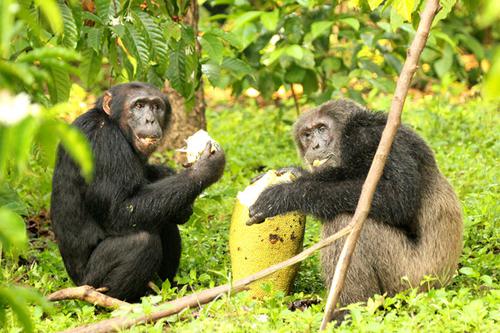当前位置:
X-MOL 学术
›
Am. J. Primatol.
›
论文详情
Our official English website, www.x-mol.net, welcomes your
feedback! (Note: you will need to create a separate account there.)
Forest fragments become farmland: Dietary Response of wild chimpanzees (Pan troglodytes) to fast-changing anthropogenic landscapes.
American Journal of Primatology ( IF 2.0 ) Pub Date : 2020-01-16 , DOI: 10.1002/ajp.23090 Matthew R McLennan 1, 2, 3 , Georgia A Lorenti 1, 2 , Tom Sabiiti 2 , Massimo Bardi 4
American Journal of Primatology ( IF 2.0 ) Pub Date : 2020-01-16 , DOI: 10.1002/ajp.23090 Matthew R McLennan 1, 2, 3 , Georgia A Lorenti 1, 2 , Tom Sabiiti 2 , Massimo Bardi 4
Affiliation

|
Behavioral flexibility, including an ability to modify feeding behavior, is a key trait enabling primates to survive in forest fragments. In human-dominated landscapes, unprotected forest fragments can become progressively degraded, and may be cleared entirely, challenging the capacity of primates to adjust to the changes. We examined responses of wild chimpanzees (Pan troglodytes schweinfurthii) to major habitat change: that is, clearance of forest fragments for agriculture. Over 7 years, fragments in Bulindi, Uganda, were reduced in size by 80%. We compared the chimpanzees' diet at the start and end of this period of rapid deforestation, using data derived mainly from fecal analysis. Similar to other long-term study populations, chimpanzees in Bulindi have a diverse diet comprising over 169 plant foods. However, extensive deforestation seemed to impact their feeding ecology. Dietary changes after fragment clearance included reduced overall frugivory, reduced intake of figs (Ficus spp.; formerly a dietary "staple" for these chimpanzees), and reduced variety of fruits in fecal samples. Nevertheless, the magnitude of most changes was remarkably minor given the extent of forest loss. Agricultural fruits increased in dietary importance, with crops accounting for a greater proportion of fruits in fecal samples after deforestation. In particular, cultivated jackfruit (Artocarpus heterophyllus) became a "staple" food for the chimpanzees but was scarcely eaten before fragment clearance. Crops offer some nutritional benefits for primates, being high in carbohydrate energy and low in hard-to-digest fiber. Thus, crop feeding may have offset foraging costs associated with loss of wild foods and reduced overall frugivory for the chimpanzees. The adaptability of many primates offers hope for their conservation in fragmented, rural landscapes. However, long-term data are needed to establish whether potential benefits (i.e. energetic, reproductive) of foraging in agricultural matrix habitats outweigh fitness costs from anthropogenic mortality risk for chimpanzees and other adaptable primates.
中文翻译:

森林碎片成为农田:野生黑猩猩(Pan troglodytes)对快速变化的人为景观的饮食反应。
行为灵活性,包括改变进食行为的能力,是使灵长类动物能够在森林碎片中生存的关键特征。在人为主导的景观中,未受保护的森林碎片可能会逐渐退化,甚至可能被完全清除,这挑战了灵长类动物适应变化的能力。我们研究了野生黑猩猩(Pan troglodytes schweinfurthii)对主要生境变化的响应:即清除森林碎片以用于农业。7年多来,乌干达Bulindi的碎片减少了80%。我们使用了主要来自粪便分析的数据,比较了这片快速砍伐森林开始和结束时黑猩猩的饮食。与其他长期研究人群相似,布林迪的黑猩猩饮食也多样化,其中包括超过169种植物性食物。然而,广泛的森林砍伐似乎影响了他们的饲养生态。清除碎片后的饮食变化包括减少整体食欲,减少无花果的摄入(无花果(Ficus spp。);以前是这些黑猩猩的饮食“主食”)以及粪便样品中的水果种类减少。然而,鉴于森林流失的程度,大多数变化的幅度都很小。农业水果的饮食重要性增加,森林砍伐后农作物在粪便样品中占更大比例。尤其是,栽培的菠萝蜜(面包果)成为黑猩猩的“主食”,但在碎片清除前几乎没有食用。作物为灵长类动物提供了一些营养益处,碳水化合物能量高而难消化的纤维含量低。从而,农作物的饲喂可以抵消与野生食物的损失和黑猩猩总体食味减少有关的觅食成本。许多灵长类动物的适应性为其在破碎的乡村景观中的保护提供了希望。但是,需要长期数据来确定在农业基质生境中觅食的潜在收益(即能量,生殖)是否超过了因黑猩猩和其他适应性灵长类动物的人为致死风险而产生的健身成本。
更新日期:2020-04-13
中文翻译:

森林碎片成为农田:野生黑猩猩(Pan troglodytes)对快速变化的人为景观的饮食反应。
行为灵活性,包括改变进食行为的能力,是使灵长类动物能够在森林碎片中生存的关键特征。在人为主导的景观中,未受保护的森林碎片可能会逐渐退化,甚至可能被完全清除,这挑战了灵长类动物适应变化的能力。我们研究了野生黑猩猩(Pan troglodytes schweinfurthii)对主要生境变化的响应:即清除森林碎片以用于农业。7年多来,乌干达Bulindi的碎片减少了80%。我们使用了主要来自粪便分析的数据,比较了这片快速砍伐森林开始和结束时黑猩猩的饮食。与其他长期研究人群相似,布林迪的黑猩猩饮食也多样化,其中包括超过169种植物性食物。然而,广泛的森林砍伐似乎影响了他们的饲养生态。清除碎片后的饮食变化包括减少整体食欲,减少无花果的摄入(无花果(Ficus spp。);以前是这些黑猩猩的饮食“主食”)以及粪便样品中的水果种类减少。然而,鉴于森林流失的程度,大多数变化的幅度都很小。农业水果的饮食重要性增加,森林砍伐后农作物在粪便样品中占更大比例。尤其是,栽培的菠萝蜜(面包果)成为黑猩猩的“主食”,但在碎片清除前几乎没有食用。作物为灵长类动物提供了一些营养益处,碳水化合物能量高而难消化的纤维含量低。从而,农作物的饲喂可以抵消与野生食物的损失和黑猩猩总体食味减少有关的觅食成本。许多灵长类动物的适应性为其在破碎的乡村景观中的保护提供了希望。但是,需要长期数据来确定在农业基质生境中觅食的潜在收益(即能量,生殖)是否超过了因黑猩猩和其他适应性灵长类动物的人为致死风险而产生的健身成本。











































 京公网安备 11010802027423号
京公网安备 11010802027423号